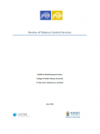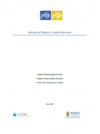In New Zealand, tobacco use contributes significantly to health loss from cancers (mainly lung cancer) as well as the burden of cardiovascular disease and diabetes. Cardiovascular disease and cancer are the major causes of death in New Zealand, and rates are much higher among Māori.
In March 2011 the Government agreed to ‘a longer term aspirational goal of reducing smoking prevalence and tobacco availability to minimal levels, thereby making New Zealand essentially a smoke-free nation by 2025’. This was in response to Parliament’s Māori Affairs Committee Inquiry into the tobacco industry in Aotearoa and the consequences of tobacco use for Māori.
This publication outlines the findings of a review commissioned by the Ministry of Health to determine whether the services that are currently in place to address tobacco related harm are sufficient to support achievement of the Government’s Smokefree Aotearoa 2025 goal. The recommendations outlined in the report were formulated based on an extensive review of the evidence and existing services, as well as input from key stakeholders.
Methodology
The review consisted of four phases: evidence review, map of tobacco control services, consultation with tobacco control sector, and identification of gaps and opportunities.- Evidence review: A review and summary of published evidence relevant to tobacco control service delivery models and approaches was undertaken. The focus of the review was on services that address high rates of smoking in priority populations and interventions that achieve value for money.
- Map of tobacco control services: A map of current tobacco control services was developed using multiple sources.
- Consultation with tobacco control sector: An online consultation process was undertaken and three face to face consultation meetings were held. Three consultation meetings were held with Ministry of Health personnel responsible for tobacco control policy and operations.
- Identification of gaps and opportunities: This analysis was informed by the three earlier phases of the research and additional relevant data and research.


